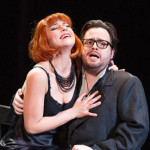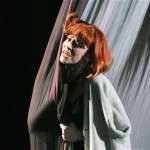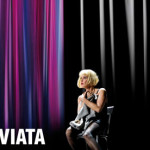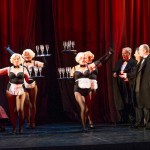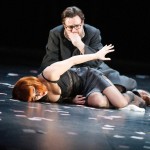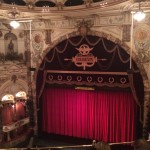Going to the opera in London is a rare treat, not for some maybe but certainly for me, and even more so for my friend Elaine. Its reputation is that above the cultural dividing line, yet opera remains enduring popular among young and old, rich and poor alike – helped by the fact that while top ticket prices for the fat cats go into the hundreds, it is possible to buy cheap seats – if you ware quick off the mark and don’t mind suffering for your entertainment.
Bear in mind that opera is expensive to stage, what with orchestra, performers, costumes, crew and prime real estate in central London, so subsidy is the only way it can remain the high point of our cultural firmament. Upkeep of the ornate and gilded premises alone must lead to bills that would scare the life out of most of us.
Clearly the strategy has something going for it: I bought almost the last two consecutive seats for the last night of La Traviata at the London Coliseum, performed by English National Opera. They cost £25 apiece, which by London West End standards is not at all bad – though not reflective of the cost to stage the production, which may be one argument in favour of a cut-down performance – of which more anon.
However, for those in doubt about whether opera is the ENO had thought through why we might want to see Verdi‘s masterpiece. This is what their website suggests as valid arguments in favour:
1. Experience one of the world’s best-loved operas. Hugely popular, Verdi’s heartrending tragedy is the most performed opera in the repertoire. A starkly resonant tale of society and morality, it tells the moving story of the beautiful but fragile courtesan Violetta.
2. Get a fresh perspective on this classic opera. With a modern and uncluttered staging, Peter Konwitschny’s production cuts to the very heart of the opera’s themes of passionate love and tragic death. Watch the trailer to see scenes from the show.
3. It’s a thoroughly enjoyable evening’ ★★★★ Sunday Express, Nominated for an Olivier Award in 2013, our production is loved by critics and audiences: ‘#ENOTraviata is the best thing I’ve seen in YEARS. Stripped back, honest and so moving.’ @NatDaySop
4. Be moved to tears by Verdi’s sublime music. La traviata is one of Verdi’s most emotionally engaging works. Filled with hugely powerful music, you’ll instantly recognise some of the composer’s most famous melodies. Listen to music clips >
5. See it performed by our stunning cast. We’re excited to launch a major star with the UK debut of rising soprano Elizabeth Zharoff as Violetta, alongside ENO Harewood Artist Ben Johnson who revives his ‘knockout performance’ (The Times) as her lover Alfredo.
Convinced? No doubt most of the critics were (see here and here and here, for example), though there are different ways of looking at this particular elephant.
La Traviata, literally “the fallen woman”, is a romantic tragedy worthy of Romeo and Juliet. Verdi set to music the libretto of Francesco Maria Piave, based on La Dame Aux Camélias, the novel by Dumas fils. A classic theme from a classic source by a great composer, one revived very regularly by operatic companies the world over, and therein lies the challenge: like Shakespearean productions, each staging of La Traviata must bring some new interpretation, expressed through which cuts are applied, the staging, acting, choreography, music and more – which is less than easy.
This production is of the modern school, which is to say it would probably not appeal to the classicist school, for example. ENO’s production was, being the English National Opera, in English, which would be an affront to the purist though it does enhance accessibility for potential new audiences. You could argue that regardless of language the availability of a translation displayed on the screen above the proscenium arch provides all the accessibility you need, and to understand the true beauty of the libretto knowledge of Italian does not always matter. Like many songs in French, they have an innate beauty that simply does not translate into English, let alone scan or rhyme.
However, language is not likely to be the key issue here. The “stripped back” and stylised staging would be an anathema, if not an affront to those who expect the illusion of reality to be portrayed. In some ways it is as much a distraction as having a staged packed with fripperies. There is space, and much too much of it. For all the colossal stage at the Coliseum, there is an awful lot of empty black stage on display at any given point – empty acres that at times reminded me of the swathes of white plate presented in nouvelle cuisine restaurants, such that nothing becomes as important as something, the stylistic presentation is provided to match the content.
Lighting is stark and simple. Props are restricted to one chair, some glasses, a pile of books and playing cards flicked bizarrely in the air to mimic gambling among the well-to-do. That said the chorus of hooray Henries and Henriettas is choreographed beautifully, not unlike a crocodile of naughty schoolchildren clad in evening dress – so I could forgive them a lot. Perhaps this is why some of the most successful scenes are those in which the chorus fill the empty space, a marked contrast to when the lovers adorn a clear stage, much as if it were a rehearsal room.
Oh yes, and we must discuss the curtains. When first the red velvet drapes open at funereal pace to the delicate, haunting melody of the overture, we are presented with a view of…. more red velvet drapes. When they too are finally unfurled we see – you guessed it – more red curtains. And more… layer upon layer of curtains, which are eventually torn down in the throws of nihilism as Violetta’s world comes crashing down around her ears. Symbolically, not long before her tragic death, shortly after she is reunited with her beloved Alfredo, the lovers mime closing the curtains. All very clever, particularly when Violetta “dances” with the curtains too – but ultimately this is a conceit.
Costumes are not overwrought. The chorus is adorned with black evening wear, though Alfredo is garbed like an academic, short only of arm patches on his comfortable cardy. There is probably some significance to Violetta’s shift from black to blonde to red wigs, though that one sadly passed me by, though her clothes make the more logical passage from vivid crimson to deathly black via homely, comfortable clothes for her domestic period in Act 2.
The benefit of such a conceit is that it allows us to focus on the searing emotional tragedy in the piece, and naturally the music of Verdi. This is where the production comes into its own. The music is transcendent, perhaps more than the acting: if you did not know what the characters were singing about, could you tell from their behaviours and interactions?
The best known example from this piece being the drinking song, though the music goes through a range of modes and moods, from romantic arias through passion, anguish, fear, hatred and ultimately regret. The moods of the music are thrilling and sublime, even when the lyric occasionally jars. Ultimately the music is what carries the opera on a magic carpet ride; it voices the emotion and carries the audience with a wave of sound, starting with the major keys of the first act and descending into minor keys as the tragedy unfurls.
Elizabeth Zharoff carries it off with verve and passion, making light of the complex trills and triplets to convey her complex character, unexpectedly loved and finding herself loving him back, contrary to all previous experience she finds she is out of her depth. Ben Johnson‘s Alfredo communicates his love with eloquence, but also his confusion at Violetta’s apparent u-turn of affections towards him. In the absence through sickness of Anthony Michaels-Moore, Charles Johnston stepped up to play a splendidly overbearing Giorgio, Alfredo’s father, the cause of the heartache between the lovers. He appears with his daughter in Act 2, whose presence on stage is almost unique among revivals of La Traviata.
That we were spellbound says much for the production, in spite of the downside of cheaper seats in a plush old theatre. We were up in the gods (ie. the balcony) in claustrophobic seats that crushed my legs. This being a 1 hour 50 minute show without an interval, I had long since developed cramp and restless legs, but did not have the luxury of standing up, stretching legs or even taking a breath of fresh air from the hot and sticky atmosphere. Perhaps a little suffering is good for the audience, helping us to feel Violetta’s pain?
There is good and bad in any stylistic interpretation. This one is the marmite of operatic convention, so maybe a flawed production in a flawed environment, but with more than ample virtues to make a night at the opera a memorable experience.
For novices: if you haven’t tried it, please put opera on your bucket list, for this is something you won’t easily forget and, who knows, may even enjoy! Goodness knows, we were applauding through ten minutes of curtain calls so we had time aplenty to appreciate the fervour.
But if you think opera is not for you, remember that it is at heart a drama every bit as much as your favourite soap opera. Of this I am certain: the final moment where Violetta sings with a spring in her step that she is feeling much better while gradually fading from the light and beyond the final curtain – this will stay long, long in my memory. Such is the nature of tragedy.
PS. Further interesting analysis about La Traviata in the Guardian:
“A whore must always be a whore,” wrote Giuseppe Verdi, a furious response to the censors in Rome who had demanded changes to his opera La traviata to make the story of the courtesan Violetta more palatable to a conservative public, and a startling statement of his radical vision of his opera. At the height of his self-confidence and compositional maturity in his 40th year, Verdi had turned away from biblical stories and historical dramas to confront his audiences with a drama that dealt with some of the great moral and social dilemmas of the 19th-century world: prostitution, disease, and human passion. Or as Verdi put it in his first title for La traviata (“The Fallen Woman”): Love and Death.
But it wasn’t just in Rome that there was controversy. First performed in Venice in 1853, La traviata came to London in 1856. And here too, the reaction from the great and the good – well, the Times and Illustrated London News – was of self-righteous moral indignation: “An exhibition of harlotry upon the public stage. It is the poetry of the brothel … All the interest is concentrated upon the death-struggles of this wretched girl. It is for her that pity is asked, and it is to her that pity is given. Now, we say that, morally speaking, this is most hideous and abominable.”
His opera’s music didn’t go down well with some of those London critics either: “The claims of the Traviata, as a musical work, are poor indeed, and it required something extraordinary in the way of representation to lift it from the oblivion to which it was evidently doomed.” One of the most popular and most performed operas in the world today, the anonymous author of those words would have to do more than a Paddy Ashdown, and eat an entire millinery.
But La traviata didn’t just touch a nerve with the leader writers, those self-appointed guardians of the moral compass of the British Empire. There was a feeling at the time that the entire imperial edifice was under threat from the contagion of sexual promiscuity and its concomitant physical diseases. La traviata exposed an open wound of hypocrisy, misogyny and sexual politics at the heart of European society. And in revealing it for his audiences, in creating that problematic but indelible “pity” for Violetta through his music, Verdi confronted head-on some of the social difficulties in his own life as well.
Verdi’s journey towards La traviata begins in a theatre in Paris in 1852, where he and his partner, the soprano Giuseppina Strepponi – the mother of at least four illegitimate children, a woman who had reached the end of her career by the time she was in her early 30s, whose then unmarried relationship with Verdi scandalised the good burghers of his home town Busseto – saw the theatrical sensation of the season, Alexandre Dumas’s La Dame aux camélias. A fictionalised account of Dumas’s affair with the real-life courtesan, Marie Duplessis, the play was based on his novel, which in turn built on Marie’s fame. Dead at just 23, she was one of the most feted figures of the demi-monde, whose funeral in 1847 was attended by a glittering array of French aristos – who had rented her out on a nightly basis and bought shares in her body.
But Verdi’s Violetta is much more than Dumas’s consumptive heroine. The essential arc of the story – Violetta’s life of pleasure, Alfredo’s entreaties of love, her escape with him to the country, her sacrifice of this new life because of the social outrage of Alfredo’s father, and her death from tuberculosis – is the same, but Verdi goes further in his music than Dumas does in his story to make Violetta the centre of any audience’s sympathies. It’s because of the directness and daring of Verdi’s music that La Traviata was perceived by those big beasts of supposed moral rectitude in the press as being so dangerous. Verdi doesn’t just put a contemporary story on stage, he sets it all to contemporary music, too: the waltzes and polkas that had taken Europe by storm were the sounds that accompanied the libidinous pleasures of booze and sensuality, and which were thought to encourage moral corruption through the corporeal abandon of their relentless rhythms. The most famous of those is the drinking song in the first act of La traviata, which I promise you know even if you think you don’t: Alfredo’s waltzing “Libiamo” – “let’s get pissed”, basically.
Yet it’s in his music for Violetta in the final act that Verdi clinches his heroine’s fate and clutches our hearts. Violetta doesn’t go out with a display of vocal acrobatics, but rather with music of distilled, dignified and heart-rending simplicity in her aria “Addio, del passato”, her farewell to “dreams of the past”. It’s here, at her weakest moment physically, that we experience her true moral strength, her enduring belief in the transforming, redeeming power of love. As one of the great Violettas of the last 50 years, Dame Josephine Barstow says to me in the forthcoming BBC2 film: “Violetta taught me how to love.”
Neither the censors nor the critics in London were listened to in 1856. La traviata became an instant success, especially with female audiences, and Violetta’s agonising ability to touch us is still vividly realised at every performance of the opera, which you can hear somewhere in the world pretty much every night of the year. But we should remember that this is a work that Verdi meant to change us and confront us, not as an operatic consolation. Violetta’s searing message of the fate of “fallen women” is one we still need to hear.
- La traviata: Love, Death And Divas, presented by Tom Service and Amanda Vickery, is on BBC2 at 9pm on 20 June and will be available for a month on iPlayer.




